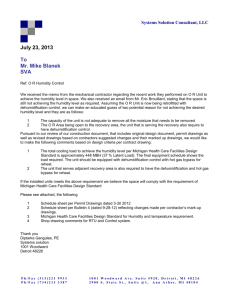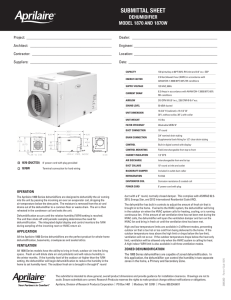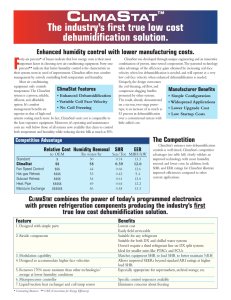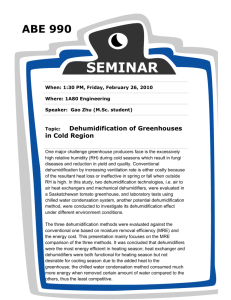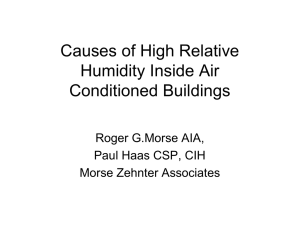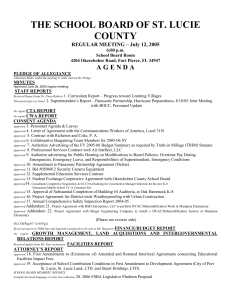Dehumidification
advertisement
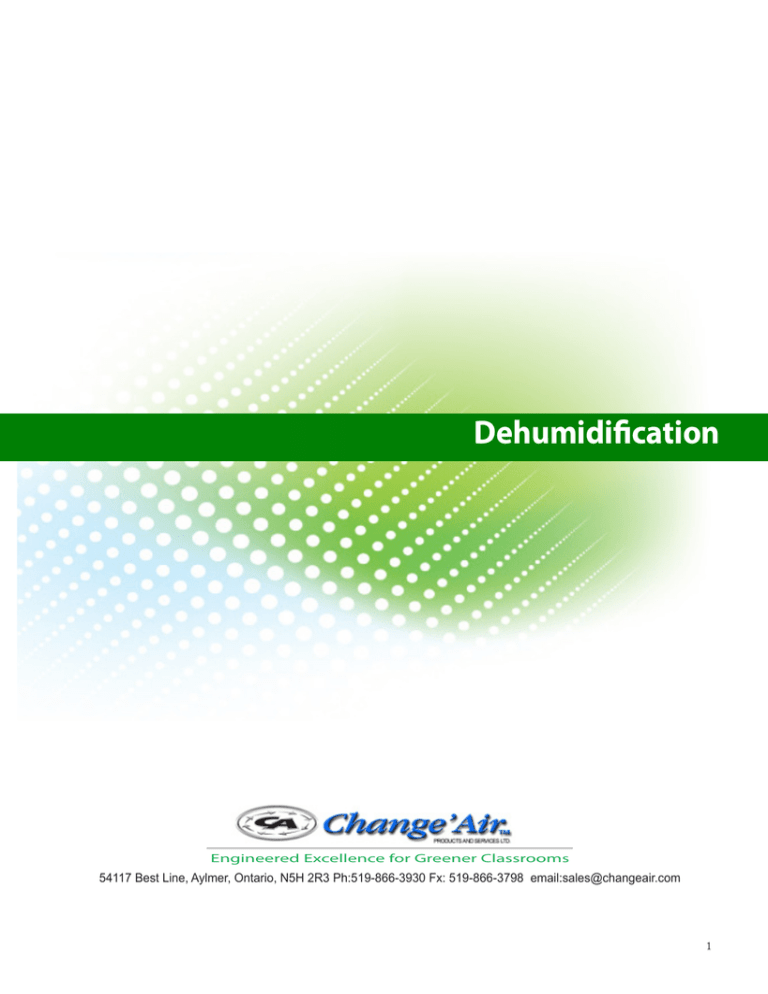
Dehumidification Engineered Excellence for Greener Classrooms 54117 Best Line, Aylmer, Ontario, N5H 2R3 Ph:519-866-3930 Fx: 519-866-3798 email:sales@changeair.com 1 Dehumidification Dehumidification Understanding and Addressing It. Understanding Dehumidification The invisible water vapor in the air is called humidity. The amount of water that can be contained in the air depends upon the temperature of the air and the pressure of the air. The amount of water present or the degree of saturation is evaluated in terms of relative humidity (RH). Taking this water out of the air is called dehumidification. So what does relative humidity mean to us and the buildings we live, work and learn in? Levels above 60% RH can negatively impact human health, comfort and productivity. High humidity problems can also lead to significantly increased energy consumption and capital costs. Examples of these would be lower than reasonable thermostat settings to achieve comfort, or in extreme cases, damage to building materials and structures by high humidity. HVAC and Dehumidification Many control systems and HVAC designs are not equipped to lower humidity and therefore result in damp cool environments unhealthy for both the structure and the occupants. Most HVAC equipment removes moisture by reducing the temperature or “refrigeration dehumidification”. When air is cooled the capacity to hold water decreases and the extra water vapor condenses. Control systems work closely with the HVAC equipment to effectively control this aspect of air quality. Humidity also affects the cooling load on air conditioning equipment and as a result the size of the equipment. Air conditioning equipment is designed primarily on cooling load and when very humid air is introduced as “fresh air” that load goes up significantly. To compensate for the higher load the size of the equipment increases. This creates a problem when the oversized air conditioning unit meets space temperature but has not operated for a long enough period to dehumidify. The result is cool but damp environments. 2 HVAC & DEHUMIDIFICATION Many control systems and HVAC designs are not equipped to lower humidity and therefore result in damp cool environments unhealthy for both the structure and the occupants. Dehumidification Recommendations and Solutions If your application is a school classroom or similar application requiring incoming fresh air, Change’Air recommends the following design techniques for reducing heavily loaded fresh air. 1. Match the amount of fresh air introduced into the room environment to the human occupancy load through tools such as CO2 monitors. This cost effective option can significantly reduce the need to cool and dehumidify air typically pumped into a room that does not need it. 2. Design equipment with fresh air energy recovery. This is a very effective way of “precooling” and also dehumidifying the incoming fresh air through desiccant wheels or fixed plate enthalpy cores. Simple physics moves some of the moisture and temperature from the hot humid incoming air to the cool dry air that is pushed outside to statically balance the building. 3. Use a unique dual cooling coil design. This type of design is often engineered for the southern states where humidity levels are extreme. A primary cooling coil is positioned in the traditional position and then a second cooling coil is placed where it is dedicated to incoming fresh air only. This approach allows only the “dehumidification coil” in the fresh air to operate on a more continuous basis pre-treating the fresh air and greatly reducing the load on the primary cooling coil. To control the size of your conditioning equipment there are several design options that can dehumidify the air without forcing an increase to high capacity units. 1. Dual stage compressors. Since the full design capacity is seldom required, partial load operation is a very effective way to match the capacity with the load. The equipment will cycle less and run longer at reduced power consumption to maintain room set point which is healthier for the equipment and the room air quality. 2. Hot gas bypass (HGB) design. For this option a metered portion of the hot, high pressure gas is redirected to the evaporator during a low load condition. The goal is to operate the refrigeration system in a healthy state with optimum superheat and subcooling numbers. This is all done automatically through temperature sensors and thermal expansion valves with the end result being a degree of capacity control. 3. Hot gas reheat (HGR) coils. When unit capacity control is not an option, or in addition to it, hot gas reheat (HGR) coils is a good option. A mechanical valve is opened when the controller signals space temperature is acceptable but RH levels are unacceptably high. The valve diverts some gas destined for the condensing coil up to a small “Desuperheating” or HGR coil positioned on the leaving side of the evaporator coil. The result is that moisture is removed from the mixed air by dropping the temperature as it passes through the cooling coil and then it is immediately warmed back up to near room temperature as it passes through the HGR coil. The system can operate as long as required and the dehumidification process is effective without dropping room temperatures. Change’Air Engineered Excellence for Greener Classrooms Change’Air has built a reputation for engineering quality HVAC products for greener classrooms. Solving classroom heating, ventilation and air conditioning issues in a sustainable and environmentally friendly way is our goal. Making the process worry free is our guarantee. 54117 Best Line, Aylmer, Ontario, N5H 2R3 Ph:519-866-3930 Fx: 519-866-3798 email:sales@changeair.com 3

